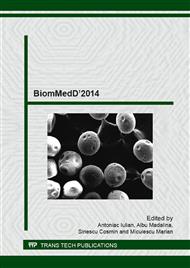p.316
p.322
p.327
p.333
p.339
p.344
p.352
p.357
p.363
Finite Element Analysis of the Linear 11 MM Screw A0623-11 Expansor
Abstract:
The aim of this study was to identify optimal constructive solutions for the linear screw expansor, building three types of devices, CAD modelling, force and torsion moments analysis, and visualization of the most vulnerabile areas, using the finite element analysis. After the clinic impression, a dental mold was obtained. The orthodontic disjunction device was obtained using a dedicated software, Solid Edge V181 in order to use it in the finite element study to observe forces and deformations that occur in the projected system. Three designs of the linear screw disjunktion device were proposed. Each component was built on a 1:1 scale. The obtained data was introduced in the software. The results show the way the orthodontic ring acts when it is cimented on the tooth. Maximal total tensions occur on the frontal part of the device, where the support component of the disjunctor is placed, and in the immediate surrounding area, meaning the arms of the expansor. Tensions get lower as we move away from the active part of the device towards the orthodontic rings. Regarding tensions on the y axes, the color coding shows that tensions get lower as they get closer to the active part of the device. In conclusion, after projecting the disjunctor and analysing it by means of the finite element, it can be said that the third design of the linear screw disjunctor is the best option.
Info:
Periodical:
Pages:
363-369
Citation:
Online since:
March 2015
Keywords:
Price:
Сopyright:
© 2015 Trans Tech Publications Ltd. All Rights Reserved
Share:
Citation:


